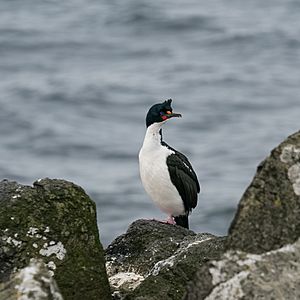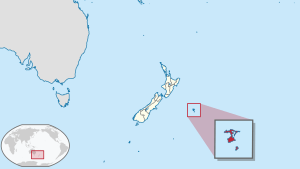Chatham shag facts for kids
Quick facts for kids Chatham shag |
|
|---|---|
 |
|
| Conservation status | |
| Scientific classification | |
| Genus: |
Leucocarbo
|
| Species: |
onslowi
|
| Synonyms | |
|
Phalacrocorax onslowi |
|
The Chatham shag (Leucocarbo onslowi), also called the Chatham Island shag, is a type of bird. It belongs to the cormorant and shag family, called Phalacrocoracidae. This special bird only lives in one place: the Chatham Islands of New Zealand.
For many years, scientists placed this bird in the Phalacrocorax group. But now, it is usually grouped with other "blue-eyed shags" from New Zealand and Antarctica in the Leucocarbo group. The bird most like the Chatham shag is the Otago shag, which lives on New Zealand's South Island.
This is a large bird with black and white feathers and a long crest on its head. It loves to stay near the coast, rarely going far from the shore. It sometimes hunts for food in the large, slightly salty Te Whanga Lagoon. The Chatham shag eats fish and sea creatures like octopuses. It rests on rocky shores. These birds live in groups, building their nests in small colonies around the Chatham Islands. We don't know much about how they raise their young. The Chatham shag is in danger because of animals brought by people, being disturbed at its nesting sites, and losing its natural home.
Contents
Understanding the Chatham Shag's Family Tree
Scientists group living things to understand how they are related. This is called taxonomy. The Chatham shag was first described by Henry Ogg Forbes in 1893. He named it Phalacrocorax onslowi. The name onslowi honors William Onslow, 4th Earl of Onslow, who was the Governor of New Zealand from 1889 to 1892.
For a long time, scientists debated where the Chatham shag fit in the bird family tree. It was often placed with other cormorants in the Phalacrocorax group. Later, it was also placed in a group called Euleucocarbo with other "blue-eyed shags" from New Zealand. Some even thought it was just a type of New Zealand king shag.
|
|||||||||||||||||||||||||||
| How the Blue-eyed shags of New Zealand are related, including the Chatham shag, based on a 2017 study. |
More recently, in 2014, a study looked at the DNA of these birds. This study showed that the Chatham shag belongs with the New Zealand and Antarctic blue-eyed shags in the group Leucocarbo. The International Ornithologists' Union now agrees with this.
The same study found that the Chatham shag's closest relative is the Otago shag. These two birds are also closely related to the Foveaux shag. All three of these shags are related to the New Zealand king shag and an extinct Leucocarbo species called the Kohatu shag.
The official common name for this bird is "Chatham Shag." It is also known as the "Chatham Island shag."
What Does the Chatham Shag Look Like?
An adult Chatham shag is about 63 cm (25 in) long. It weighs between 1,790–2,400 g (63–85 oz), which is about the same as a small dog. This bird has black and white feathers. Its throat, chest, belly, and patches on its wings are white. The rest of its body is black or black-brown.
When it's time to breed, the bird's head and neck shine with a blue metallic color. Its wings and back have a greenish shine, and other black areas look purplish-blue. It has a noticeable crest on its head and white, hair-like feathers on its neck.
Adult Chatham shags have a red patch of skin under their chin and orange-red bumps on their face and around their mouth. Even though the group name is "blue-eyed shags," this bird's eyes are brown with a violet ring around them. Its beak is dark grey, its mouth is bright red, and its legs and feet are dull pink.
When they are not breeding, these birds look similar but are duller in color. They don't have a crest or the hair-like feathers. Their bare skin parts are also duller. The bumps on their face are yellow, the eye-ring is blue, the mouth is orange, and the beak is light grey.
Where the Chatham Shag Lives
The Chatham shag lives only on the Chatham Islands. This group of islands is about 700 km (430 mi) east of New Zealand. In the Chathams, this bird stays close to the shore. It rarely goes more than a few kilometers out to sea. It prefers calm waters like bays and inlets.
It also hunts for food in the large, slightly salty Te Whanga Lagoon. The Chatham shag builds its nests in colonies along the coast and around Te Whanga Lagoon. They nest on flat areas, slopes, or wide cliff ledges.
Today, there are thirteen known colonies of Chatham shags. These colonies are found on the main Chatham Island, as well as Pitt Island, Star Keys, Rabbit Island, and North East Reef. These nesting sites are usually close to the high-tide line. Some colonies can have as many as 300 nests!
The birds rest on rocks near the shore or out at sea. They might even have different places to rest during the day and night. The Chatham shag does not migrate. It has never been seen away from the Chatham Islands. However, they do fly to other islands within the Chathams, like Mangere, to feed and rest.
Chatham Shag Behavior
Diet and Feeding Habits
Like all cormorants, the Chatham shag is a pursuit-diver. This means it swims underwater using its feet to catch prey. It then comes back to the surface to eat the small animals it caught with its beak.
We don't know a lot about what the Chatham shag eats exactly. But we do know its diet is mostly fish, like opalfish, flatfish, and bullies. It also eats sea creatures such as octopuses, squid, and cuttlefish. The Chatham shag usually hunts alone. However, sometimes it will join small groups of other shags to feed.
Reproduction and Life Cycle
Scientists don't know much about how Chatham shags reproduce. Male shags try to attract a mate with a special display. The male stands with his tail pointing up. He then throws his neck and head back towards his tail up to 13 times. While doing this, he makes a gurgling sound.
When a pair has found each other, they recognize each other at the nest. They do this by opening their mouths wide and lowering their heads. During these displays, the male makes a barking sound. The female is very quiet, only making a soft puffing noise.
Chatham shags breed at certain times of the year. The exact time they lay eggs can be different for each colony. Most Chatham shags lay their eggs between October and December. But the colonies in Te Whanga Lagoon start breeding three months earlier than others.
Their nests are made from iceplant, grasses, and other plants. They defend their small nesting areas from other shags. Birds nesting in the middle of a colony have to be careful. They might get bitten by other shags as they pass through their territories to reach their own nests.
A female Chatham shag usually lays two to four eggs. The eggs are about 59 to 63 mm (2.3–2.5 in) long and 37 to 40 mm (1.5–1.6 in) wide. They are a dull pale blue color with a chalky coating. We don't know exactly how long the eggs take to hatch, but it's thought to be around 30 days.
Protecting the Chatham Shag
The Chatham shag is facing many dangers from human activities. These birds are very sensitive to being disturbed at their nesting sites. If adults are scared, they might stampede, accidentally trampling nests. Also, silver gulls will quickly steal eggs if the nests are left alone. In some cases, whole colonies have been abandoned because people or farm animals disturbed them.
Colonies on the main islands are also at risk from animals brought by people. These include weka, feral cats, and possums. Because of these threats, the IUCN considers the Chatham shag to be critically endangered. This means it is at a very high risk of disappearing forever.
See also
 In Spanish: Cormorán de las Chatham para niños
In Spanish: Cormorán de las Chatham para niños



